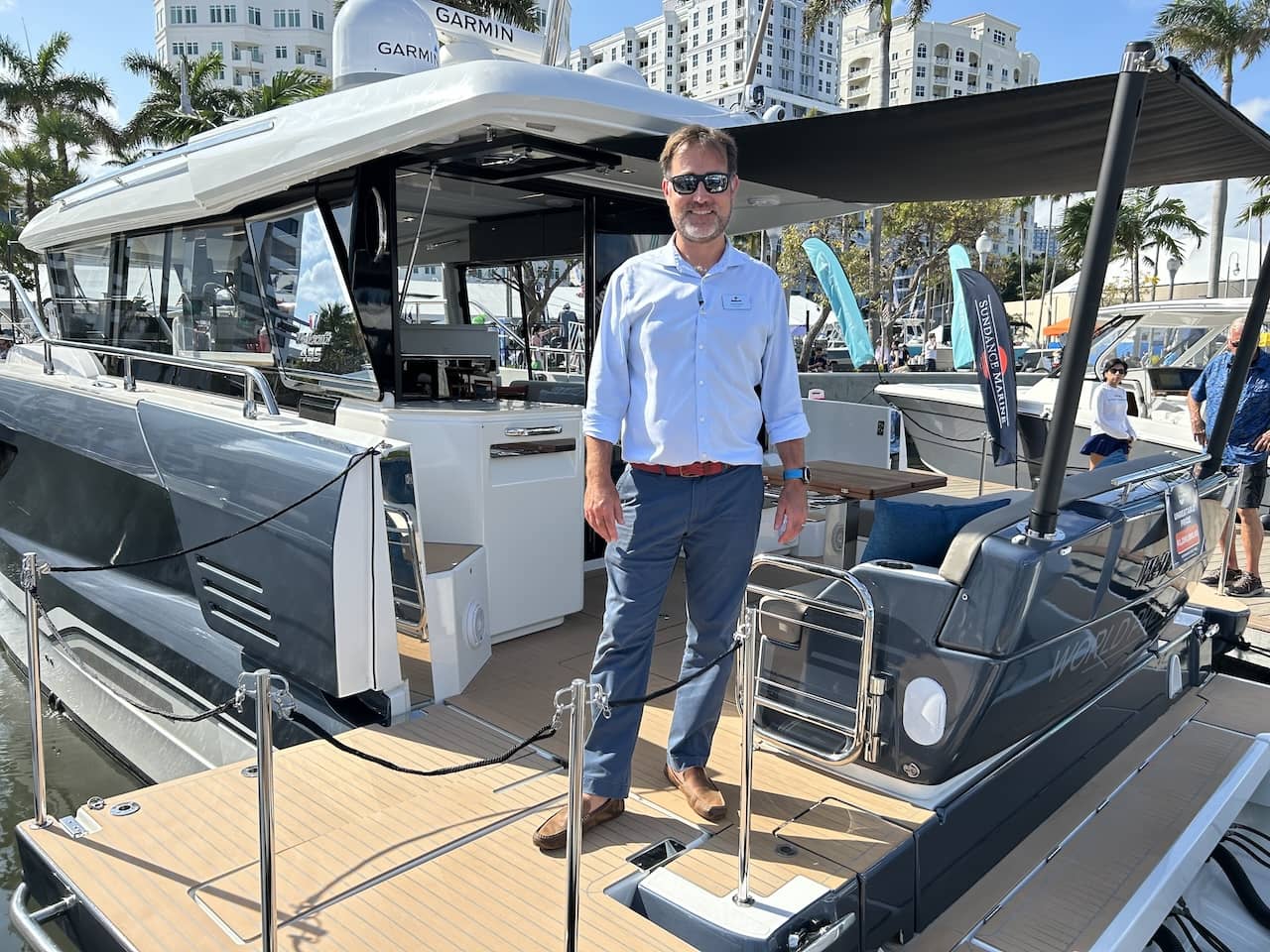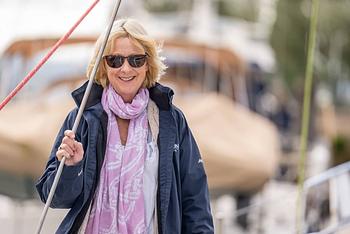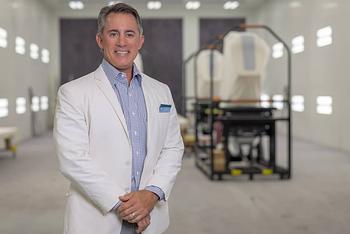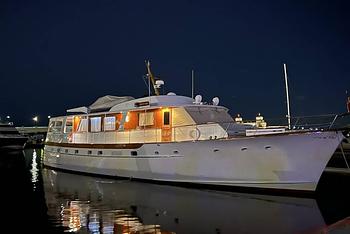After starting his career in the automotive industry, Nick Harvey joined Groupe Beneteau in 2003, spearheading the development of the popular Lagoon catamaran in North America. He then moved to France and became a senior regional sales director for the Jeanneau and Prestige brands, contributing to their rapid development in Europe and in South America. In 2014, he moved back to the United States and became president of Jeanneau America. In 2020, Groupe Beneteau named him brand director for its U.S.-based Four Winns and Wellcraft model lines.
Rightboat.com content director John Burnham recently spoke with Harvey, who shared his perspective on market trends from his office in Fort Lauderdale, Florida.
John Burnham : You’ve transitioned from Lagoon, an ocean sailing catamaran, to monohull sail and power, and now to runabouts, center consoles, and more with Four Winns and Wellcraft. What was the steepest part of the learning curve?

Nick Harvey on the expansive foldout terrace of the new Wellcraft 435 cruiser. John Burnham photo
Nick Harvey: It was an interesting jump, but the goal remains the same: Find more boaters to join in this exceptional sport. We’re catering to a potential buying population which has very different needs.
Also, because we don’t sell any of the boats direct—everything we sell is through a network of dealers—we need to make sure that dealers are equipped to answer the needs of these particular boaters.
For instance, the more entry-level the boats are, the more financing plays a role, to help boaters access the sport. It’s not like financing wasn’t important in my past roles, but it becomes more important as you’re selling a $150,000 to $300,000 boat as opposed to a million-dollar boat. It’s no secret that the higher priced boats are often paid for in cash by individuals for whom a loan isn’t necessary.
That’s one lesson in the learning curve. The dealers are also specialized in this type of boat, so they are already in the game, but what they need from the manufacturer is very different from large dealerships or brokerage houses selling the larger boats. Getting to understand what those needs are so dealers can serve the buyer was probably the steepest part of my learning curve.
Another lesson is not having direct contact with the final user or owner of the boat, like in my days at Lagoon catamarans or the Jeanneau sailboat world or with Prestige motor yachts. I could tell you 90 percent of the names of those owners. It was normal to build a relationship in those worlds, but it’s obviously different with a higher volume of sales. It’s equally as fascinating, and I’m equally as passionate about it as I was working on the other brands, but it’s an interesting difference.
Burnham : So, you’re much more engaged with the dealers?
Harvey: Supporting them is everything, and it’s also a much more competitive environment. Someone who’s interested in a runabout boat has a lot of choices, probably anywhere between 15 and 20 different brands to choose from. In the center console market, it’s quite the scene with over 90 registered brands in North America. So not only do you have dealers who may represent several brands, you have to have the right level of presence in the dealership, and you also have to make sure that your product can be recognized for what it is and really stand alone.
Burnham: Bow riders, deck boats, surf boats, cruisers, center console fish boats, multihulls: Of all these market areas you’re now involved with, what’s most exciting that consumers ought to be interested in?
Harvey: I think the core reason why people go out on the water is still the same, and it was accentuated during COVID like no one ever thought it could ever be. It’s a way to regroup with your family and find some peace and quiet and do it in the best environment, which is outdoors and in fresh air. Everybody talked about the fact that the number of new boat buyers went up by 30 percent in the COVID years.
Inside each of the segments you named is an interesting culture. Catamaran boating is becoming more popular, there are different styles, some more for day boating/cruising, which is more of a segment that we’re in with Four Winns. It’s an evolution from a bowrider or a runabout. You step off of a 25- to 26-foot runabout and onto a 30-foot catamaran. Suddenly you gain space, stability, comfort, ease of maneuvering with your engines far apart.
Yet not everybody wants the benefit of catamaran boating. When you look at the evolution of monohulls, you can see designers are trying to make monohulls more like catamarans without making catamarans at the same time.
 The “about to launch” Four Winns H9 has a speed-boat look and fold-out bulwarks for extra deck space.
The “about to launch” Four Winns H9 has a speed-boat look and fold-out bulwarks for extra deck space.
An example in power is monohull boats with foldable terraces on the sides to gain deck space. In January, we gave a sneak peak of the arrival of a new 29-foot hull which will have those terraces, the H9 bowrider. It’s unique for that size because you normally need to be in the 39- to 40-foot range to have access to this type of feature.
In the offshore boating market, there’s two clear trends. One is the boater who’s owned a center console and now wants a little more protection. A fair number of brands, including Wellcraft, arrive in that mix of Scandinavian-inspired-type boats.
The second trend: While fishing remains the number one activity that you do on a center console in America and around the world, there is a trend for more family features and fewer pure fishing features on these boats.
Performance was also a big thing back in the ‘80s and ‘90s. Wellcraft played a central role in this with its appearance in “Miami Vice,” the TV show. This preference is returning with a slightly different interpretation—more luxurious performance than pure, raw performance.
Burnham: You’ve talked about the trend of an express cruiser that’s a multihull bowrider, with protection.
Harvey: It’s more of a day-boating segment than it is a weekend or coastal cruiser. It’s also linked to the trends that we see how, in general, people use their boats. There’s a divide that’s probably getting a bit bigger between the day boaters and the people who spend longer periods on their boat.
So, the positioning of the Four Winns twin-hull series is clearly as a day boat. Jokingly, when we presented the first TH 36, we called it the bowrider on steroids.

The new Four Winns TH 36 is a cross between a bowrider, deck boat, and express cruiser. Photo courtesy Four Winns.
You take one of our hybrid deck boats, and you cut it in the middle and make it wider and longer. And you keep the attributes that everybody loves about being on a bowrider—the amount of space with an open bow, the way the cockpits are laid out, very comfortable and deep and protective. Put that on a catamaran platform and you gain a lot of stability, efficiency. You don’t have to invest in any stabilization system on top of what is inherently a stable platform.
Burnham: Your H2e bowrider won a Boating magazine award recently. How fast do you see electric power becoming a significant part of the market?
Harvey: It’s going to take a while. As far as electrification is concerned, the objective isn’t necessarily to convert somebody who’s been boating with an internal combustion engine his whole life to go electric. The idea is more to figure out how many more boaters we can bring into this sport by way of electrification. That’s key and it’s also the biggest challenge.
Where do we go to find these future boaters? They could be anywhere. It could be your neighbor, who had the first Tesla model 15 years ago, it could be your other neighbor across the street whose house is fully automated and controlled from his phone. These are the new type of clients—they hold no preconceived notions.
The electric boat in the case of Four Winns is fully connected with WiFi capabilities. So, the big questions are, as mentioned, we’re not so much looking to convert people who’ve been boating in internal combustion engine to electric; and two: We want to bring more boaters to the segment by way of electric, but it’s going to be a relatively small part of the population.

The Four Winns electric outboard bowrider runs virtually silently with a 180hp Vision Marine Technology outboard. Photo courtesy Four Winns.
If you look at the trends in automobile electrification, what we typically call innovators are 2.5 percent of the general buying population. Then it’s about attracting 13 to 14 percent of the early adopters. If you combine the two, you’re looking at maybe 16-17 percent over probably the first three or four years.
The idea at Four Winns is to be the first runabout to offer a full electric option. Right now, we’re partnered with Vision Marine Technology, and they make a 180-horsepower engine. As every boat requires a certain amount of horsepower, depending on its weight and its running surface, a lot of people come to me and say, “Why don’t you put Vision on everything?”
I can’t. With 180 horsepower, I’m pretty much limited to a 22-foot bowrider, because it would be too much power for a 20-footer, not enough power for a 24-footer. And then when you get into the bigger sizes, with twin applications, then you need twice the battery power. And that presents other challenges. You didn’t see Tesla come out with a full lineup of several models right out the gate. It’s the same for us.
Groupe Beneteau, owners of Four Winns, has multiple electrification projects, ranging from full electric such as the Four Winns runabout to hybrid systems on sailboats, and full electric systems on sailboats as well. We have seven different projects going on at the same time, all around electrification. It’s a key focus.
Burnham : Let’s discuss Wellcraft and its two models, the 355 and the 435. You’ve introduced these two, what I call sporty pilothouse Northern European-type cruisers. Who is the boater this appeals to in the U.S. and Europe?
Harvey: It’s mostly more experienced boaters who’ve boated on open-style boats, center consoles, and others, and they are now looking for more protection to widen the scope of boating. And that could mean extending the season if they’re in the Pacific Northwest or the Northeast U.S. Or in the Southeast U.S., it could mean running to the Bahamas and back without having to worry about the weather. But the common theme is protection and also running from A to B without compromising on power and speed. Another way to get more protected could be to get a trawler or a twin IPS cruising boat but this particular buyer doesn’t want to sacrifice the performance. Why not? Because he came from a center console so he’s used to that performance. That’s why we created a triple-engine boat with the Wellcraft 355.

Increased protection to run from A to B has driven sales of the new Wellcraft 355. Photo by Jean-Baptitste D’Enquin – Wellcraft.
Burnham: So the 435, the new boat, is a big sister.
Harvey: Yes, you can envision a little more comfortable weekending on that boat, although the mission remains the same, which is really to get from A to B in a wider scope of weather fully protected. The owner of the 355, the smaller of the two boats, is like the alpha male of the wolf pack. And the 435 owner is probably the guy who was the alpha male 10 years ago, and who has graduated to a little bit of a tamer boat that’s still aggressive looking. So, the 435 owner is still showing the young alpha male how things are done. That’s our positioning of the 435.
Burnham: Regarding the manufacturing, you build Wellcraft and Four Winns on both continents. Does this offer any advantages to buyers?
Harvey: Manufacturing is all about efficiency and delivering value to our owners, 85 to 90 percent of whom are located in America. We build the 355 Wellcraft in a factory in Poland, where we specialize in boats ranging from 26 feet to about 40 feet. The 435 is built in the factory in France, where we specialize in boats ranging from 40 to about 65 feet. Our Cadillac, Michigan, facility is a sport boat facility that is very good at what it does in the 20-to 35-foot range. So we concentrate a number of brands under that roof, to benefit from all of these industrial efficiencies.

The new Wellcraft 435 isn’t quite as fast as the 355 but provides a much more significant interior. Photo courtesy Wellcraft.
Burnham: Let’s talk about DNA. What can Four Winns customers count on?
Harvey: It’s an incredible story of three brothers and their dad who found an existing boating factory in 1975 and saw a huge potential in it—a story of passionate boatbuilders. They decided, the four of them, to rebrand it Four Winns after their last name. They wanted to be a family-owned company that built the best boat for family boating.
They worked extremely hard at it over the years. They focused on ease of use of the boat. They patented a running surface called Stable Vee in the early 1990s. And they focused on the quality of the upholstery inside the boat to give the feel of a plush interior.
Essentially, they always made daring choices in material bought from other vendors. The example we use all the time is the windshield. On every Four Winns runabout, there’s a specific type of windshield that’s tailor made, called a cross-curved windshield, which is not only curved horizontally, around the helm in the co-pilot area, but also curved vertically to give an automobile retro look.
Four Winns has evolved over the years and as it gets more refined, it becomes more iconic, which is where we are today. We have this incredibly iconic name that is synonymous with instinctive boating, easy-to-use plush materials, and daring choices. You can find many runabout companies that will buy a much simpler windshield without the bright chrome header on the top or the lacquered pillars on the side. And maybe they’ll be a more affordable price, but we can take it to the next level. We recently decided to change the tagline of Four Winns. It used to be “life should be a beautiful ride,” focused on the actual ride of the boat. But now we’ve changed it to “the finer side of life” to encompass the entire experience of boating. We are as true to our DNA and our values as we are daring and innovative as you saw with the latest renderings of the H9 that has those two terraces that open up on the side of the boat, bringing that much more space and usable water access around the stern.
The company has changed hands a few times; we’ve owned the Four Winns brand since 2014. But I can tell you that every bit of blood that runs through the Four Winns factory in Cadillac, Michigan, is as strong as it was 50 years ago.
Burnham: In many ways, in the large runabout and center console markets, finding what defines you and really committing to it sounds like what you’ve done under Groupe Beneteau—you’ve embraced what you had and doubled down on it.
Harvey: Definitely. It raised a few eyebrows when people heard that Four Winns was going to have a line of catamarans. They were surprised by it more than anything, but when you look at the profile of our Four Winns catamaran buyers, they’ve been boating on the runabout, and they see the huge benefit of boating on a catamaran with this amount of deck space and stability and efficiency.
The 36-foot Four Winns twin hull is probably comparable to a 43- to 44-foot monohull. And we push to 35 or 36 knots with a pair of 350s. To go that speed on a monohull on 43 or 44-footer, you need three engines, if not four.
Burnham: Same question for Wellcraft: What can your customers count on that the brand has always stood for, even if it’s not necessarily the next episode of “Miami Vice”?
Harvey: Our approach is in a fashion similar to what we’re doing with Four Winns, although on a completely different level. We wanted to be very true to the Wellcraft DNA. That means pushing the limits all the time. We offer everything from a line of center console boats for fishing to a line of performance cruisers in a cabin style, to the recently announced family sport boat, but nothing is compromised in performance.
What does it really mean to push the limits? Limits of what? The limits of comfort, the limits of speed, the limits of the type of weather that you can go out in. That’s our claim today. It’s a brand that is full of energy and really focused on delivering a comfortable and safe and fast experience on the water.
Look at the structure of the 355, for example. It’s a 36-foot boat that probably has double the amount of structural ribs than you’d find in a conventional 36-foot cruising boat. We use the latest and greatest technology. For instance, the 355 has a hull that’s manufactured using a process called infujection, which is a mix of vacuum bag infusion, resin infusion, and injection. We actually inject the resin in a mold inside the mold to make sure that our structure at the bottom of the hull that created the rigidity of the running surface is fully bonded with the actual outer layer of the hull itself. We don’t just talk about it, we do it.
That’s what convinces an owner that they’re better off boating on a Wellcraft than they would be on any other center console or performance cruiser boats out there. It’s very adrenaline driven. We’re showing that 70 years of experience still translates well into everything we do now. It’s a “can’t stop, won’t stop” type of mentality, that we want to push through the future development of Wellcraft, and it’s been fun. We’re planning a big celebration of Wellcraft’s 70-year history in 2025 in the company birthplace of Sarasota, and the “Miami Vice” tie is always the highlight of the historical conversation.
Burnham: You’ve been completely absorbed in this for three and a half years now. Did you ever think that your path with Groupe Beneteau would lead you one day to immersion in the American DNA of powerboating?
Harvey: Personally, I don’t really question it or think about it that much. I’m just passionate about boating first and foremost. I started with the sailing side of the business, but now I’m as comfortable operating a 50-foot sailing catamaran or a 50-foot sailing monohull as I am a 65-foot Prestige flybridge motor yacht or a Four Winns H2e. I’m more passionate about the industry and passionate about everything that this industry brings in terms of smiles to people’s faces and connection with their family and being outdoors.
Burnham: You started in the car industry originally. How did you move to boating?
Harvey: I went to college in France and in England, so I have a dual degree. And I did two internships: one with a company in the car industry in London, and a second with Lagoon Catamarans in France. When I graduated, I sent two resumes, one to Groupe Beneteau and one to the car company, and the car company hired me. It took about five or six years to then reconnect with Groupe Beneteau and eventually go to Maryland to head up sales for Lagoon Catamarans. I always look back and think it’s ironic that out of college I got hired by the car company, not the boat company, but I learned a lot. And I think it also served me in my career in the boat business.
Related Articles and Guides
24th Jul 2024
Rightboat Interview: Buying & Selling Cruising Yachts with Sue Grant of Berthon ...
10th Jun 2024
Rightboat Interview: From Style to Construction, Talking Center Consoles and Sco...
1st May 2024
Popular Cruisers and Classic Yachts of Rightboat
16th Apr 2024






